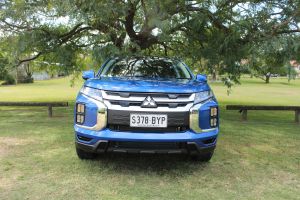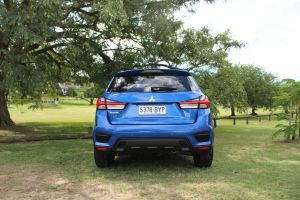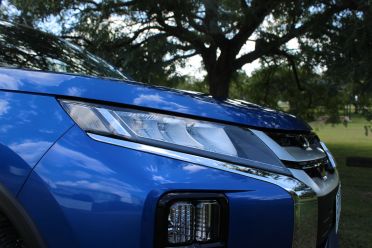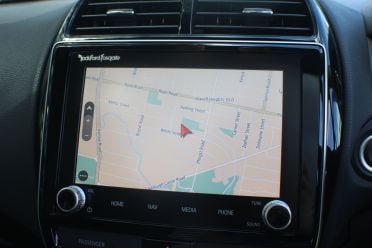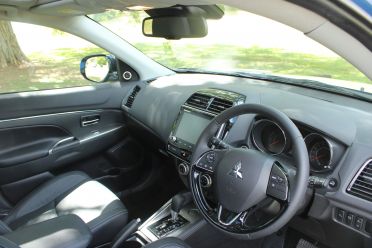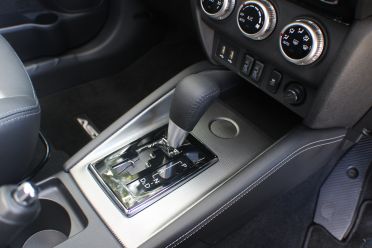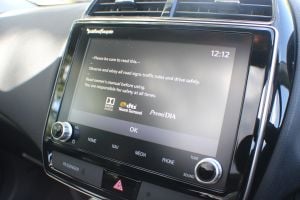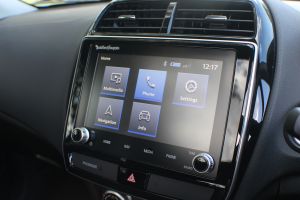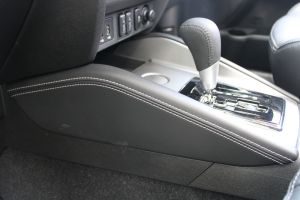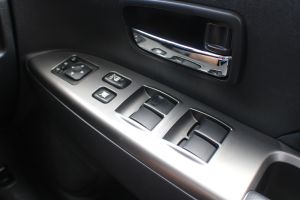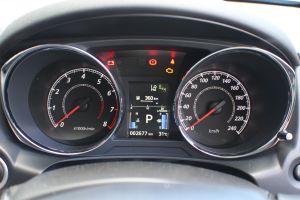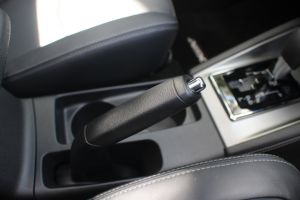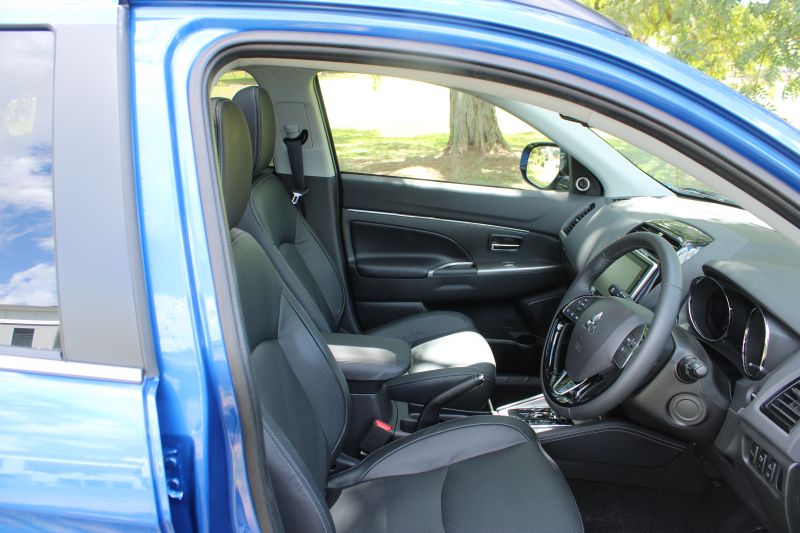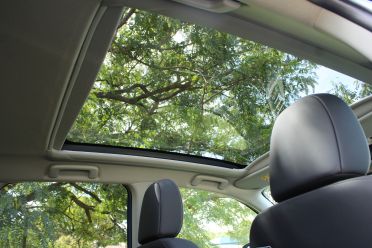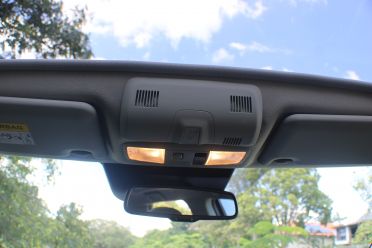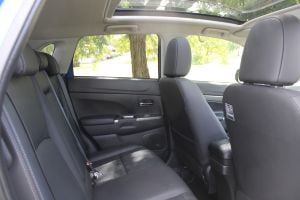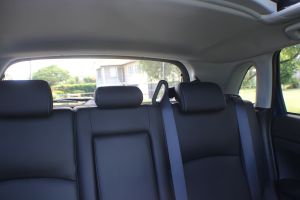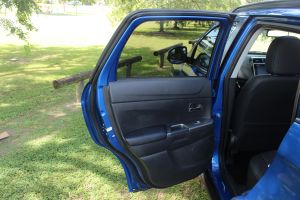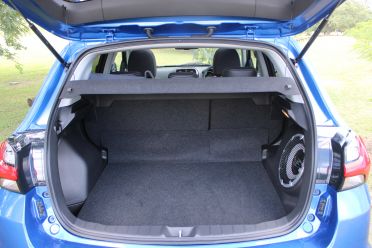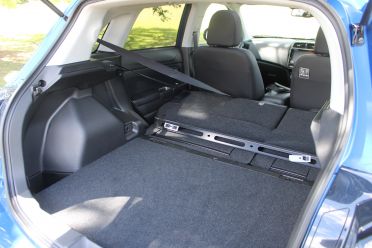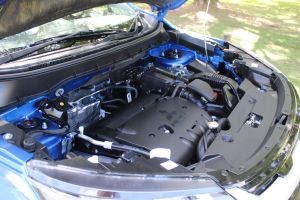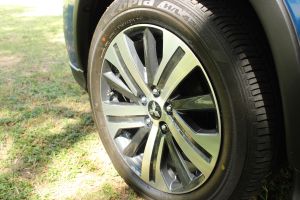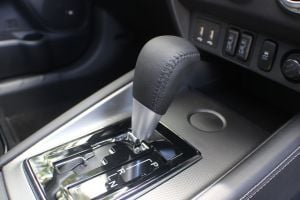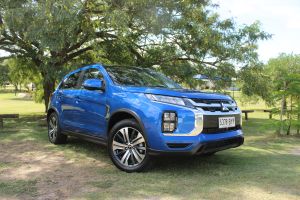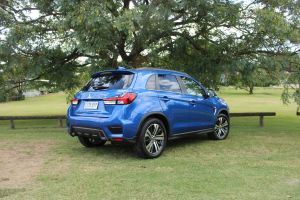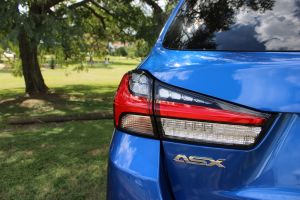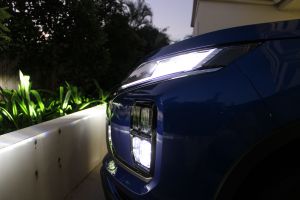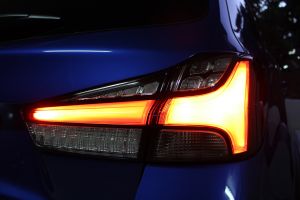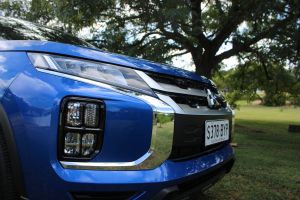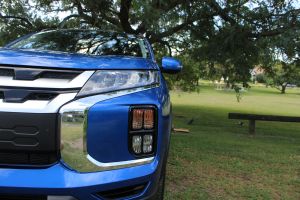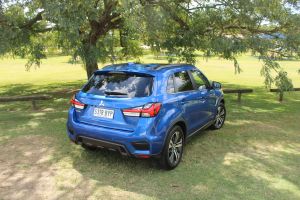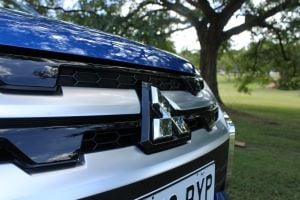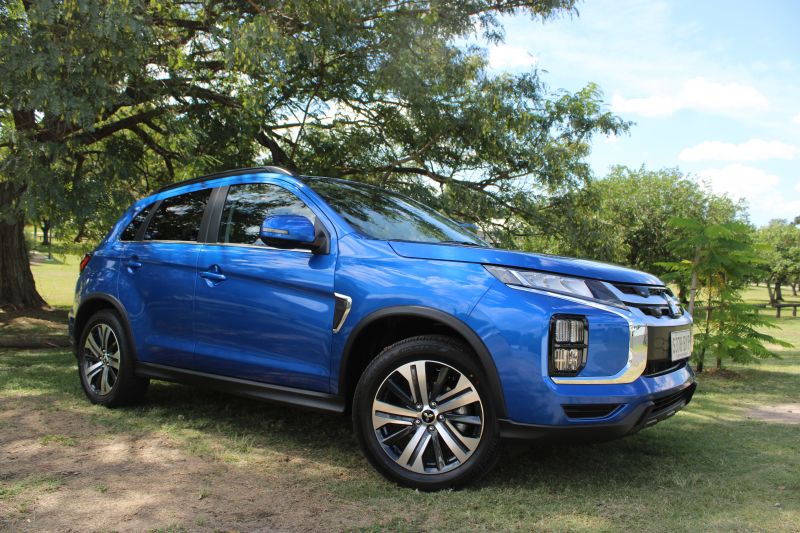You’d be forgiven for wondering why the Mitsubishi ASX is still around.
But really it’s obvious why Mitsubishi keeps the 10-year old small SUV in its showrooms. Even against fresher competition, the ASX continues to be the best-selling vehicle in its segment.
The development costs were likely amortised long ago, and the ASX can just print money for Mitsubishi.
Last year, the company sold 20,806 ASXs. The Mazda CX-3 was a distant second in the segment, with 14,813 units sold.
But the ASX isn’t Mitsubishi’s only small SUV. When Mitsubishi launched the almost identically-sized Eclipse Cross in 2017, it seemed logical it would serve as the ASX’s replacement or, at the very least, take over from the up-spec ASX trim levels.
Mitsubishi, however, not only kept the hot-selling ASX around, last year it added a new, more powerful petrol engine and two new trim levels at the top of the range – the GSR and the featured Exceed.
In Exceed trim, the ASX is priced smack-bang in the middle of the Eclipse Cross’s price range. Despite its advanced age, it’s also looking pretty handsome after last year’s facelift.
Staying fresh?
Even after three facelifts the ASX still looks good
It presents a more cohesive visage than earlier ASXs, with a bolder and better-integrated Dynamic Shield grille and attractive LED exterior lighting.
And though the ASX dates back to 2010, Mitsubishi has made small tweaks and upgrades along the way, including last year’s facelift, to keep it fresh.
It’s rare for a car to look better after three facelifts than it did at launch but, defying the odds, the ASX’s exterior styling has aged like fine wine.
Has the rest of the package followed suit?

How much does it cost?
The ASX Exceed is priced at $33,240 before on-road costs. That’s almost $10,000 higher than a base ASX ES manual, which costs $23,990 before on-road costs.
It costs $1050 more than the mid-range Eclipse Cross LS with front-wheel drive.
What do you get?
All ASX models come standard with LED headlights and daytime running lights, 18-inch alloy wheels, climate control air-conditioning, and a leather-wrapped steering wheel and shifter.
Also standard is an 8.0-inch touchscreen infotainment system with Android Auto and Apple CarPlay.
ES ADAS models add automatic headlights and rain-sensing wipers, while LS models add keyless entry with push-button start.
As expected for a range-topping model, the ASX Exceed adds plenty of fruit on top of this.
This includes satellite navigation, a panoramic glass roof, and a nine-speaker Rockford Fosgate premium sound system.
Seats are trimmed in leather and heated up front, with the driver’s seat gaining power adjustability.
You won’t find adaptive cruise control, lane-keeping assist, or ventilated seats on any ASX model.
Even more disappointingly, you also won’t find rear air-conditioning vents.
How safe is it?
The ASX boasts a five-star rating from ANCAP but there’s an important caveat there – it was assessed back in 2014.
The ASX range, excluding the ES and MR, features standard autonomous emergency braking with forward-collision warning and pedestrian detection, as well as lane-departure warning (but no lane-keeping assist), rear cross-traffic alert, and blind-spot monitoring.
There are also front, front-side and curtain airbags, plus one for the driver’s knees.
What’s the ASX like on the inside?
The ASX dates back to a time where a touchscreen infotainment system wasn’t standard fitment in a small SUV.
It shows.
Compare a 2020 ASX against a 2011 ASX and you’ll see the interior has changed very little in that time.
The dashboard is the same, though the infotainment system has become standard fitment since the ASX’s debut and the software has been upgraded.
The touchscreen is integrated well enough in the dashboard but its interface looks dated and it can be slow to react to inputs.
The worst part is the satellite navigation, exclusive to the Exceed.
It’s powered by TomTom and it looks (and operates) like one of the systems you would’ve bought to plug into your cigarette lighter a few years ago.
It’s rife with annoying idiosyncrasies. For example, when you first select Navigation from the infotainment system’s main menu, the map is massively zoomed out.
You have to tap the zoom button several times – it’ll beep loudly, as everything does in the ASX – and then you’ll be able to see where you are.
Flashback to 2010
The ASX cabin has changed little in ten years
There are other annoying idiosyncrasies to be found in the ASX’s cabin.
The climate controls are recessed in the centre stack and harder to reach than they should be. The heated seat controls are buried even further down.
The switchgear looks old and cheap, like it’s a coat of silver paint away from being in an old Grandis or 380.
The power window controls on the door don’t even light up, while the stalks for the indicators and wipers feel brittle.
Also, everything beeps. If you flick between trip computer screens or adjust the volume via the steering wheel or do anything on the touchscreen, the car will beep.
The cluttered trip computer screen is another sign of the ASX’s age. It also lacks a digital speedometer.
The trip computer is unintuitive. Just one button controls it, meaning there are no arrow or enter buttons. You just have to keep pressing the same button or, to enter sub-menus, hold the same button for a few seconds. It took a read of the owner’s manual to figure out that last part.
You sit up high in the ASX, which many buyers will appreciate.
The front seats are overly firm and the leather trim isn’t the nicest stuff Mitsubishi could’ve used. They also don’t feature three-stage heated seating like most heated seats. Nevertheless they’re tolerable, except for one major flaw.
Both front seats were already creaking loudly despite our tester having just under 3000km on the odometer. The driver’s seat also felt like it rocked slightly on its base.
That’s extremely disappointing for a brand new car, and doesn’t inspire confidence. At least there were no other build quality issues in the interior.
In the plus column – a smaller column, mind you – the ASX uses soft-touch plastic for the top of the dash and front doors. There’s even some leatherette used on the centre console.
The ASX Exceed’s interior does have one ace up its sleeve. That’s the huge, panoramic glass roof. It can’t be opened but that also means there’s no central bar obstructing your view.
It’s also lined with orange LEDs. They look a little cheap – like emergency aircraft lighting – but they add some visual interest.
Visuals aside, the ASX interior is functional.
Passengers in the rear enjoy a reasonable amount of space. It’s roomier than a Mazda CX-3 back there and easier to see out of than a Toyota C-HR, though it doesn’t feel as spacious as a Kia Seltos.
While there’s plenty of toe room, headroom is lacking. If you’re 180cm or taller, you’ll find your head brushing the roof.
Rear passengers also don’t have any air vents or USB outlets, nor is there any storage back here. The seat base is also quite short, potentially compromising long-distance comfort.
If your rear passengers are little, there are three top-tether and two ISOFIX anchor points for child seats.
Opening the tailgate reveals a 393L boot and a giant subwoofer that looks like it’s out of the Strathfield catalogue.
The rear seats split and fold 60:40, expanding cargo volume to 1193L.
What’s under the bonnet?
The ASX Exceed and GSR use a naturally-aspirated 2.4-litre four-cylinder engine producing 123kW of power and 222Nm of torque and mated to a continuously-variable transmission (CVT).
That’s a bump of 13kW and 25Nm over the atmo 2.0-litre in the rest of the ASX range.
All ASX models use front-wheel drive.
What’s the ASX like to drive?
The ASX has an uncanny ability to make 123kW feel like too much power for the chassis.
Punch it from a stop and there’s frankly an astonishing amount of torque steer – tugging of the wheel to the side – for something with the ASX’s outputs.
In fairness, the ASX Exceed’s 2.4-litre has slightly more power than many rivals and its 222Nm is high for the class.
Only the Eclipse Cross and Renault Kadjar have more torque, though the Suzuki Vitara Turbo and S-Cross come very close.
Spirited driving yields an orchestra of squealing tires straight out of a ‘70s cop movie.
The wheel turns too much when you don’t want it to (torque steer) and not enough when you do want it to (understeer).
The understeer is the bigger bother of the two, the ASX reluctant to respond to inputs and communicating little of what’s going on underneath.
“But hold on,” you might be thinking. “Nobody’s going to drive an ASX like this!”
You’re probably right. But if you do value driving enjoyment, a Kia Seltos or Mazda CX-3 is going to be a better bet.
Other than the perverse pleasure that can be found in seeing how much tyre noise you can generate going around corners, there’s little joy to be found driving the ASX.
In typical, day-to-day driving, the ASX is more impressive. Or, more accurately, it’s comfortably average.
Noise suppression is average, with that old-school, drawn-out drone of the CVT as you pick up speed.
More annoyingly, the engine can be raucous and there’s a fair amount of wind noise around the mirrors at highway speeds.
How does it go?
Sufficient power but insufficient fun
Ride quality is decent. The ASX takes a second to recover from larger bumps and imperfections in the road but it feels neither too bouncy nor too harsh.
The 2.4-litre/CVT combo results in relatively peppy performance, though the ASX can feel strained when tackling steep hills around town.
There’s a sport mode for the transmission but it doesn’t make the ASX feel much snappier. It sure seems to make it noisier, though. Just leave it in Drive.
Fuel economy stayed quite close to Mitsubishi’s claims.
With the 2.4-litre, the ASX is said to consume 7.9L/100km on the combined cycle. In mostly urban driving, our tester achieved 8.6L/100km.
It requires only 91RON regular unleaded fuel.
How much does the ASX cost to run?
The ASX requires servicing every 12 months or 15,000km, whichever comes first.
Since 2017, Mitsubishi has been offering three years of capped price servicing, with each service costing $199.
The company has sweetened the pot more recently, bumping its warranty up to seven years and unlimited kilometres to match Kia. The company is also currently offering two years of free servicing.
CarExpert’s take on the 2020 Mitsubishi ASX Exceed
You’d have to be seduced by that expansive glass roof to choose the ASX Exceed over a mid-range Eclipse Cross.
The next SUV up in Mitsubishi’s range feels two generations newer because, well, it is.
The venerable ASX isn’t a bad car, per se.
It performs competently around town, has a reasonable amount of cabin space, and looks handsome. Those attributes help explain the car’s enduring commercial success.
Perhaps it has maintained its stranglehold on the segment because other small SUVs looked too strange (Nissan Juke), didn’t feel much fresher (Nissan Qashqai) or didn’t seem to be designed with small families in mind (CX-3 and C-HR).
Now, however, there’s a car that bests the ASX in everything from interior design to driving dynamics: the Kia Seltos.
The ASX’s faults are all too apparent, especially when pitted against the Kia.
In almost every respect, the ASX feels like a ten-year old car.
It can’t even boast a tantalisingly low price to offset this. A Kia Seltos Sport+ can be had with almost all the ASX Exceed’s features for just over $1000 less – although it’s worth noting Mitsubishi is known for doing sharp deals. Haggle hard.
The ASX fell short of excellent when it launched almost a decade ago and, though Mitsubishi has made intermittent updates, time hasn’t been kind.
There’s better value to be had lower in the Mitsubishi ASX range, our rating here is for the top-specification model, which doesn’t provide value for money in what is a competitive segment.

